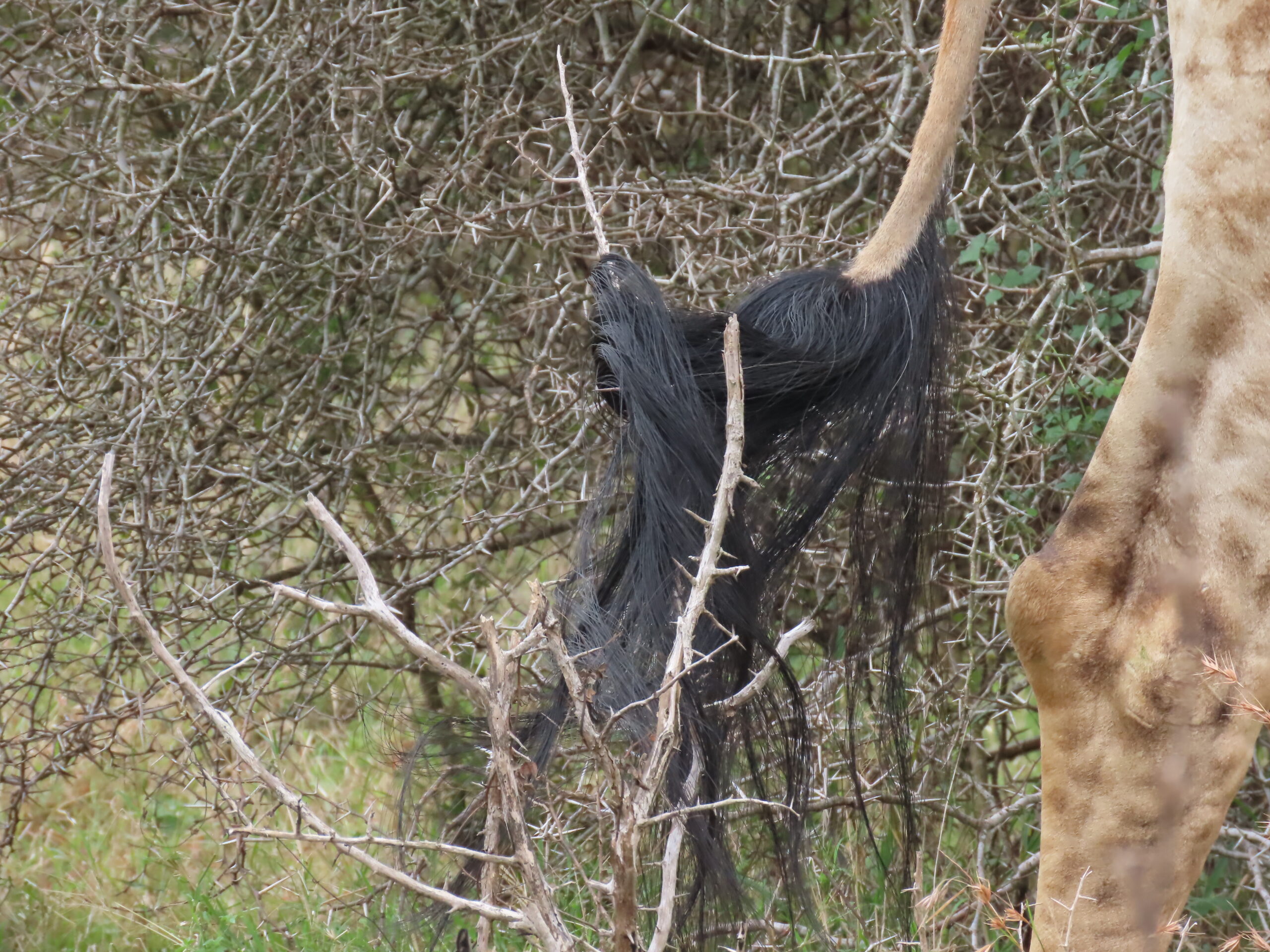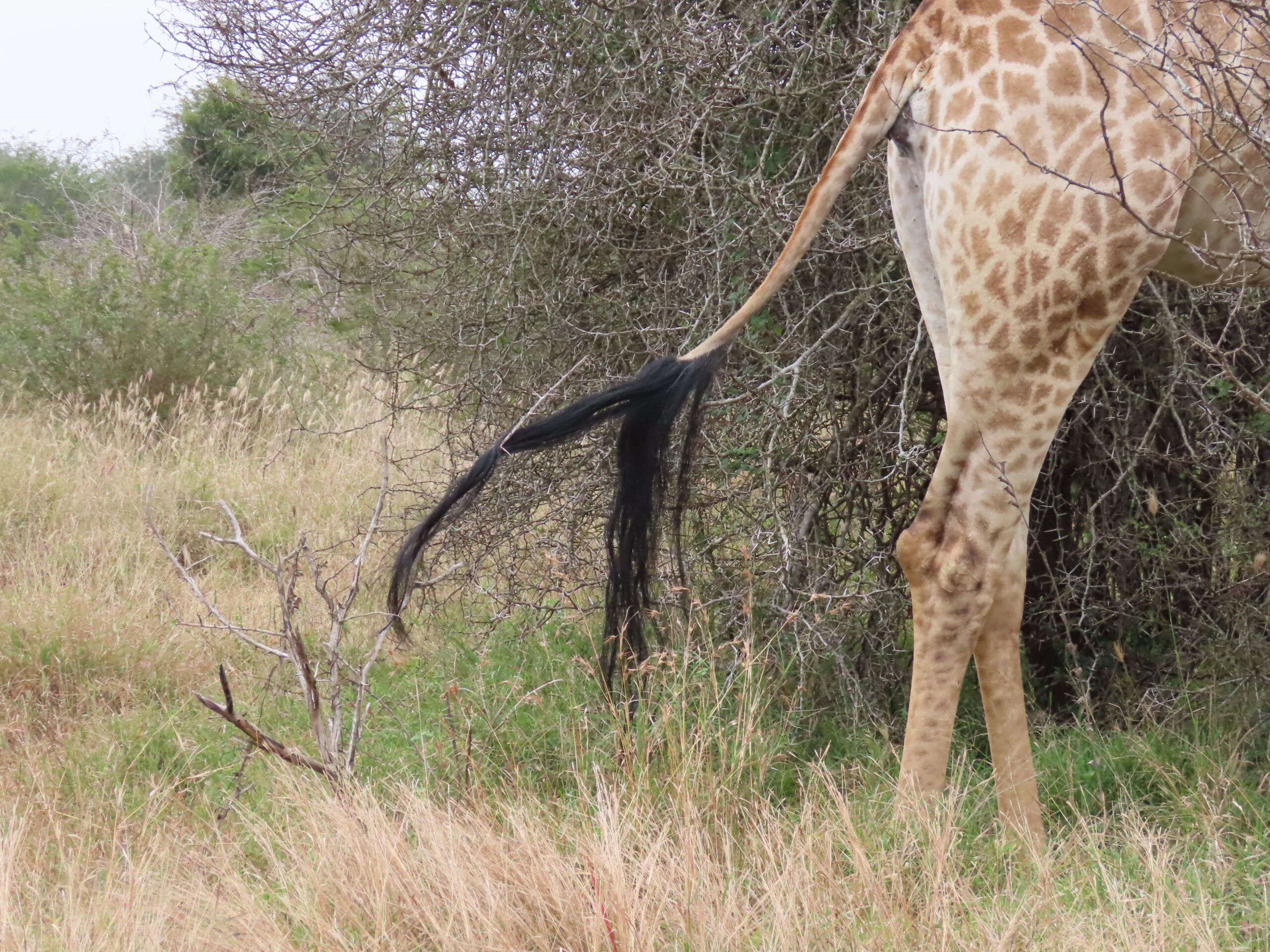Please watch this video. It’s unlike any video we’ve taken in the past when this giraffe got its hairy tail stuck in a thorny bush. We didn’t know it was going to be able to get loose. But, with her massive size and strength, she could wrangle herself free and wander off.
It was one more of the enchanting sightings we experienced in Kruger National Park on our visit on Thursday this past week when finally, the holiday season had ended, and we felt comfortable entering the park. Previously, there were so many visitors in Kruger it was impossible to get photos at a popular sighting. The vehicles would have been congested at sightings with 20 to 30 vehicles. That wouldn’t have been our idea of a good time.

But, when we conducted a self-drive after the holiday, we encountered few vehicles, even at the leopard sighting shown in the post two days ago, found here.
By no means is today’s post the end of our sightings on Thursday. It could go on for many more days while we accumulate new photos from sightings in our garden over the past few days. Right now, as I write here on Sunday at 1:00 pm, 1300 hrs., we have no less than six kudus lying down in the garden with another six standing. They’ve been here for hours.
The animals seem to love it here and feel comfortable hanging around for hours, letting their guard down long enough to sleep, rest and munch on leaves on the bushes and trees, along with our occasional offer of pellets. The longer we are here, the more wildlife seems to make this garden their part-time home in the case of warthog, Lollie, her permanent home. She leaves for a few hours during the afternoon but always returns late afternoon, staying through the evening.

As for giraffes, well, what can we say? They are magnificent animals, and we’ll never tire of encountering them, whether here in Marloth Park or Kruger National Park. For a few updated facts on giraffes, please click here.
What are giraffes?
They are the world’s tallest mammals. They are uniquely adapted to reach vegetation inaccessible to other herbivores. Unusually elastic blood vessels and uniquely adapted valves help offset the sudden buildup of blood (to prevent fainting) when giraffes’ heads are raised, lowered, or swung quickly. Their “horns” are actually knobs covered with skin and hair above the eyes that protect the head from injury. Their necks contain the same amount of vertebrae as we do (seven) except their bones are extremely elongated making their neck a long length of 2.4 meters.
GIRAFFA CAMELOPARDALIS
MALES: 1,930 KILOGRAMS (4,254 POUNDS) FEMALES: 1,180 KILOGRAMS (2,601 POUNDS)
5.7 METERS TALL FROM THE GROUND TO THEIR HORNS (18.7 FEET)
AVERAGE 10 TO 15 YEARS IN THE WILD; RECORDED A MAXIMUM OF 30 YEARS
DENSE FOREST TO OPEN PLAINS
HERBIVOROUS
BETWEEN 13 AND 15 MONTHS
HUMANS, LIONS, LEOPARDS, HYENAS, CROCODILES

Challenges
Humans hunt giraffes for their hides, meat, and body parts.
Giraffe tails are highly prized by many African cultures and are used in good-luck bracelets, fly whisks, and even thread for sewing or stringing beads. The world’s tallest land animal has lost 40 percent of its population in just 30 years, and recent reports show poaching and wildlife trafficking are contributing to this decline. Giraffes are easily killed and poaching (now more often for their meat and hide) continues today. (Today, giraffes are often killed for their tails which are used as jewelry. Horrible!)
Giraffes are quickly losing their living spaces.
The number of giraffes in the wild is shrinking as their habitats shrink. In the late 19th and 20th centuries herds of 20 to 30 animals were recorded, now on average herd sizes contain fewer than six individuals. The IUCN lists four main threats to this species: habitat loss, civil unrest, illegal hunting, and ecological changes (climate change and habitat conversion). As human populations grow and increase agricultural activities, expand settlements, and construct roads, the giraffe is losing its beloved acacia trees, which are its main source of food.
Solutions
Our solutions to saving the world’s tallest land animal from extinction:
AWF has reforested acacia trees in West Africa to provide more food for the giraffe and allow it to expand its habitat.
We educate communities living near giraffes on the importance of sustainable practices for agricultural and settlement growth by providing training on sustainable — and more productive — agricultural practices and incentivizing conservation agriculture when appropriate.
Behaviors
Young giraffes are self-sufficient but vulnerable.
Calves are about two meters tall and grow rapidly as much as two and a half centimeters a day. By two months, the calf will start eating leaves and at six months is fairly independent of its mother. A young giraffe can even survive early weaning at two or three months. Although few predators attack adults, lions, hyenas, and leopards take their toll on the young. Scientists report that only one-quarter of infants survive to adulthood due to the high rates of predation.
Diet
Giraffes are extremely picky eaters.
They feed 16 to 20 hours a day, but may only consume about 30 kilograms (about 30 pounds) of foliage during that time. These two-ton mammals can survive on as little as seven kilograms (15 pounds) of foliage per day. While these browsers’ diverse diets have been reported to contain up to 93 different plant species, acacia trees have been found to be their favorite food source.
They are not heavy drinkers.
Giraffes drink water when it is available, but they don’t need to drink water on a daily basis, which allows them to survive in areas with scarce water.”
When we spotted this precious giraffe and its stuck tail, we were reminded of the poaching happening today for their beautiful tails. From this site here.
“There have always been animal parts that drew humans’ attention, without any clear reason whatsoever. Sadly, we’re used to crimes like the slaughter for elephant tusks, rhino horns and crocodile skin. So, the fact that giraffes are hunted and killed for their tails could appear as new to us. Yet, this is what’s happening in the Democratic Republic of the Congo and what’s pushing a rare giraffe subspecies, the Kordofan giraffe (Giraffa camelopardalis antiquorum), to the brink of extinction. According to Julian Fennessy, co-director of the Giraffe Conservation Foundation (GCF), less than 2,000 individuals now survive in the wild.”

Last night, we had a great evening at Alan and Fiona’s. They put on quite a feast of mostly low-carb options we could enjoy. The conversation was fascinating, profound, and thought-provoking, along with enjoying the plethora of wildlife visitors that visited their garden while we were there.
I’ve been busy all morning making a special Sunday dinner, photos that will follow in a few days. Have a fantastic day and evening!
Photo from one year ago today, July 24, 2021:
There was no post on this travel day, one year ago.
